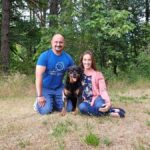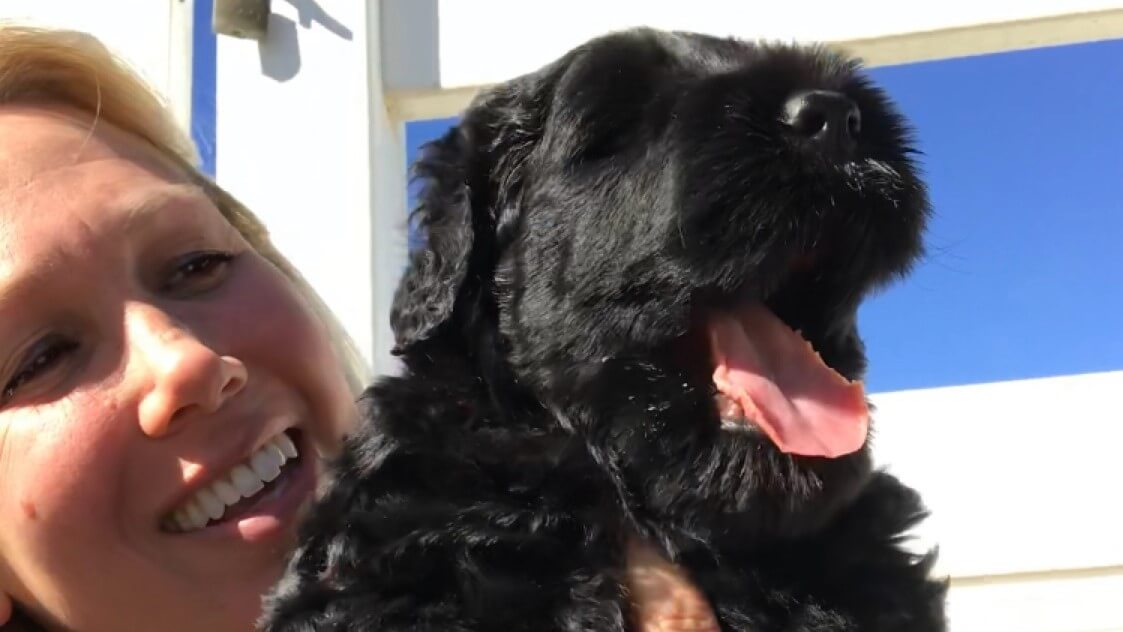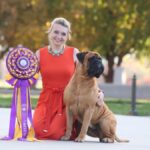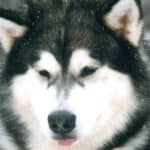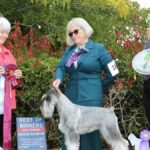Interview with Christine Robinson, Ph.D., Breeder of Black Beard Black Russian Terriers
- Please tell us a little bit about yourself. Where do you live? How many years in dogs? How many years as a breeder? What is your kennel name?
- What is your “process” for selecting show puppies? Performance puppies?
- In your opinion, is your breed in good condition overall? Any trends that warrant concern?
- As a Preservation Breeder, can you share your thoughts on the sport today? How’s the judging these days? What do you think about the number of shows?
- In your opinion, is social media good for the sport? Is it harmful?
- What are the biggest challenges facing the dog show community as a whole today and how can these be addressed?
- What are some of the positive changes you’ve seen in the sport over the past decade?
Christine Robinson, Ph.D.
1. My husband, Stewart, and I live in sunny Southern California. We have been involved in breeding dogs for nearly 40 years, having bred from four different AKC Groups. We have been showing Black Russian Terriers for 15 years. Our AKC registered kennel name is Black Beard. The name “Black Beard” is an homage to our first BRT, “Thatch,” who was named after Black Beard, the English pirate. We are Bronze Level Breeders of Merit for Black Russian Terriers.
2. That selection process starts from birth. Based on experience, I can often see which puppies will make the short list for show prospects when they are born. Personality traits and characteristics develop over the next several weeks. We begin stacking puppies at around three weeks. Their temperaments and natural tendencies develop as early as five weeks. As the puppies develop physically and coordination improves, I introduce unique opportunities to help them explore their environment by including objects and games they might find in performance sports, including scent articles, tunnels, orange cones, a platform, swing, and balance discs. Between our observations, results of puppy aptitude evaluations, structural evaluations by our breeder-veterinarian, and at least one other breeder and a judge, we select which puppies would be suitable for each family whether that is show, performance, or personal companion home.
3. I have concerns about the future of the breed in the United States. Preserving or even increasing genetic diversity in the breed is important. By ensuring genetic diversity, breeders can promote healthier, more resilient, and well-rounded dog populations. A diverse gene pool reduces the risk of inherited diseases and genetic disorders. When dogs are bred from a limited gene pool, there is a higher chance of passing on deleterious genes or harmful traits that can lead to health issues. Being cut off from Russia, our breed’s country of origin, could be the most serious blow to the breed’s future. Conflict in the region, coupled with political sanctions, has cut us off from an important and large population of dogs in both Russia and the Ukraine. This is a rare breed, and our US population relies on imports for diversity. Only a handful of breeders use genetic tools like the ongoing breed-specific genetic diversity study by the School of Veterinary Medicine at the University of California, Davis.
4. I am impressed with the numerous ways that AKC has employed to increase participation in the sport. While attendance at shows took a hit after the pandemic, I see a strong comeback. One of the exciting trends is the number of new judges. We need more judges. They only get experience through assignments, and I am happy to help provide a great experience for new judges. While it is fun showing to some of the GOATs, they won’t be around forever. We need new, enthusiastic, and younger judges throughout AKC. We need more breeder-judges in all breeds. In California, we are fortunate to have a large number of shows. Adding Companion sports and events to shows has helped attendance. The addition of NOHS to shows has also helped increase participation.
5. Social media is good for the sport. Many people are introduced to the sport through social media posts. The dog community comes together to congratulate each other on accomplishments and wish happy birthday to their dogs and litters; they grieve together and they encourage each other. Social media has been wonderful for sharing information about shows. It helps new judges find assignments. It helps new exhibitors with grooming and training tips. And it provides virtual introductions to a plethora of resources in the sport. Participation in the sport has grown because of social media.
6. Presently, the dog show community is challenged by the new CDC import rule that takes effect on August 1, 2024. For Black Russian Terriers, the ban on Russian imports and this new import rule are both detrimental. Relaxing the CDC import ban in North America may help the breed as Canadian and American breeders have worked closely together for three decades. Regarding the ban on Russian imports, it may help if AKC would consider allowing litter registrations from Russian sires that were collected and stored before sanctions were introduced. Frozen semen is stored in many countries outside of Russia. Presently, we cannot use dogs with RKF pedigrees for breeding, regardless of how long ago the semen was collected and stored. I’m discussing this from the perspective of a Black Russian Terrier breeder, but both of these bans also affect many other breeds.
The other significant challenge in the dog show community as a whole is the large number of people retiring from the sport (exhibitors, judges, and breeders) and the small number of new people. We need more new people to find the fun and joy in dog sports. We need more breeders to become judges. We need to mentor and encourage new, responsible breeders.
7. I’m excited about the number of new programs and activities that AKC has introduced. AKC has a new Breeder Mentor program, they have expanded courses in the AKC Canine College, and they have introduced several new titles and activities for show dogs and companion animals. There is something for everyone who loves purebred, pedigreed dogs. AKC has done a lot to promote responsible dog ownership and demonstrates the unique joy that comes from having a canine companion.
